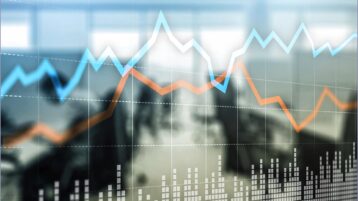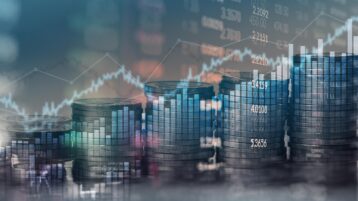Oil prices may have received a moderate boost from OPEC’s production cut, but crude is still struggling with long-term imbalances. Hussein Allidina, Head of Commodities at TD Asset Management, says there simply isn’t enough supply investment to match rising global demand.
Print Transcript
[AUDIO LOGO]
* So tell me about what OPEC's motivation is. What are they seeing that has them do this right now?
* So Kim, I think prices have been-- a few weeks ago, prices were well below where they should have been, given underlying fundamentals. Part of that, I think, was a function or a symptom of the financial contagion that we saw impacting the market. I think they were just trying to bring prices back to where they should be, i.e., they should bring prices back to levels justified by the underlying fundamentals. I think they saw the material short interest in the market and they took the knees of the shorts out, frankly.
* OK, so what does that mean then for the price range going forward? And maybe give us your thoughts in terms of the next few months, as we are entering some weakening global times that are happening, and then beyond that.
* So bottom line, I think $70 to $90 a barrel is probably where we trade over the course of the next couple of months. Definitely worried about the global economy. And the impact of the financial contagion that we've seen earlier in this year will present some challenges, I think, to global demand growth. And I think we've got to keep in mind that rates have gone up by 400, 500 basis points in the Western world, in particular. And that's going to have an impact that I don't know has been fully seen on Main Street as yet.
* All that being said, fundamentals are tight. Inventories are quite tight. Yes, if you look at the last three months, there was a build. But we also had materially warmer than normal weather, which tempered demand. When I look over the course of May through July, we have this seasonal increase in demand, as folks start driving-- summer driving season. China is coming back.
* You could see 3 million barrels a day of incremental demand between now and the peak in July. And inventories will drop. So that presents upside to prices. But I struggle to see prices going to some of the levels that folks are talking about. The triple digits, that'll happen eventually. I don't see that happening in the next couple of months because I don't think the economy can wear that.
* I want to get to the eventually. We're just not quite there yet. But I'm curious when you say, I mean, this is going to sound like a very dumb question. But when we say rates have gone up-- and you're right, like, people who are-- have fixed rate mortgages or car payments or things like that, they haven't experienced that reset yet, which is going to happen. What does that mean for oil, though? Is it just because I pay so much more for these things I have to have that I won't be driving as much, won't be flying as much?
* So just very simple example. I drive a Ford F-150. Love it. My lease payment is $600 a month. If I go and re-sign that lease today, it's $1,200 a month. That's $600 less that I have to spend on the economy, including the gasoline that goes into my car, but also, everything else that I'm buying. And that has a knock-on impact on demand-- global demand. And global demand slows, oil demand growth slows. Not talking material contraction, not talking financial crisis. Oil demand in absolute terms will grow. Is it strong enough? Is it robust enough to support prices in triple digits? I don't think so in the near term.
* OK, so let's talk about the eventually then and get out of the near term. What do you see beyond that? Maybe define that timeline.
* So when I think 12, 18, 24 months, we have not been investing on the supply side. We still use a lot of oil. If you believe that the global economy is going to grow eventually, that growth requires oil. And we're not investing on the supply side. Now, OPEC's decision actually to bring prices back up into a more fundamentally justified range will support, I think, on the margin, some investment.
* But again, because we haven't made that investment sufficiently in the last 5, 7, 10 years, because of the bear market we've been in, it takes a long time to bring production online. And US shale producers, which are the fastest to respond, continue to exhibit religion. They are not spending on incremental production. They are spending on their shareholders.
* When does that change? What would be the trigger to have something like that to see that incremental supply come online again, the swing producers, the shale producers, say, OK, I get it, we're seeing sustained triple-digit prices in the future?
* It's a very good question. So first of all, the volatility in oil that we've seen over the course of the last couple of years really challenges the ability to invest even in short cycle production. Now, for the better part of 5, 7 years, equity investors screamed at these companies not to invest and to give money back. They finally have changed and are giving money back. It's the equity investor that will have to, again, scream at the company to invest.
* That's not happening. When we sit down with these companies, the focus is not on growing your oil production. The focus is on ESG and the environment. The ESG and the environment are quite important, but there's a mismatch here, because we still use this stuff and we're not encouraging those that can grow supply to do it.
* Yeah. What does this mean then for someone who is, whether they're looking at equities on the commodity side or the commodities themselves, I mean, how should-- how should investors be thinking about this over the next, say, six months and then over the next few years?
* So I don't think you need to see triple-digit oil prices or oil prices continuing to move higher to see positive returns on either the equity side or on the commodity side. On the commodity side specifically, as inventories draw, the curve moves into backwardation. I don't want to get too technical, but--
* You can. You can. Tell us.
* A backwardated curve means the price of oil in the future, 6, 12 months out is cheaper than the price today. So as a commodity investor, I can buy the back of the curve. Today, my roll yield, just from owning the back and rolling up to the front, is 10%.
* So I-- frankly, as a commodity investor, I don't want $120, $150 oil. I'm very happy with $80 oil. I'm happy with a stable oil price and tight inventories because I collect that roll yield, right? When I get to $120 per barrel oil, $150, I start worrying about demand destruction. Can the economy handle it? $80 oil is actually a win-win for OPEC, for commodity investors, and for the consumer.
* Hmm, interesting. So longer term, is that where you see things settling out or no?
* No, I don't. I don't. I ultimately think we're going to go higher than that because I don't think we've made the investment on the supply side. And the demand side, we're not moving away fast enough. Just earlier this week, actually, we got data out of the US. 7% of the vehicles in January that were registered were EVs. That's great. That's up from 4% last year. But it's only 2% of the entire fleet in the US.
* US consumer consumes 10 million barrels a day of gasoline. That's 10% of the world's consumption just right there in the US. The substitution on the demand side is not happening fast enough. And we've forgotten about the supply side. Very little investment is happening on the upstream. Without that investment, prices will eventually, when the demand growth is there, will have to move to a level that rations demand. And that's not $80 a barrel. That's triple digits.
* Hussein, fantastic having you here.
* Thanks for having me.
[MUSIC PLAYING]
* So tell me about what OPEC's motivation is. What are they seeing that has them do this right now?
* So Kim, I think prices have been-- a few weeks ago, prices were well below where they should have been, given underlying fundamentals. Part of that, I think, was a function or a symptom of the financial contagion that we saw impacting the market. I think they were just trying to bring prices back to where they should be, i.e., they should bring prices back to levels justified by the underlying fundamentals. I think they saw the material short interest in the market and they took the knees of the shorts out, frankly.
* OK, so what does that mean then for the price range going forward? And maybe give us your thoughts in terms of the next few months, as we are entering some weakening global times that are happening, and then beyond that.
* So bottom line, I think $70 to $90 a barrel is probably where we trade over the course of the next couple of months. Definitely worried about the global economy. And the impact of the financial contagion that we've seen earlier in this year will present some challenges, I think, to global demand growth. And I think we've got to keep in mind that rates have gone up by 400, 500 basis points in the Western world, in particular. And that's going to have an impact that I don't know has been fully seen on Main Street as yet.
* All that being said, fundamentals are tight. Inventories are quite tight. Yes, if you look at the last three months, there was a build. But we also had materially warmer than normal weather, which tempered demand. When I look over the course of May through July, we have this seasonal increase in demand, as folks start driving-- summer driving season. China is coming back.
* You could see 3 million barrels a day of incremental demand between now and the peak in July. And inventories will drop. So that presents upside to prices. But I struggle to see prices going to some of the levels that folks are talking about. The triple digits, that'll happen eventually. I don't see that happening in the next couple of months because I don't think the economy can wear that.
* I want to get to the eventually. We're just not quite there yet. But I'm curious when you say, I mean, this is going to sound like a very dumb question. But when we say rates have gone up-- and you're right, like, people who are-- have fixed rate mortgages or car payments or things like that, they haven't experienced that reset yet, which is going to happen. What does that mean for oil, though? Is it just because I pay so much more for these things I have to have that I won't be driving as much, won't be flying as much?
* So just very simple example. I drive a Ford F-150. Love it. My lease payment is $600 a month. If I go and re-sign that lease today, it's $1,200 a month. That's $600 less that I have to spend on the economy, including the gasoline that goes into my car, but also, everything else that I'm buying. And that has a knock-on impact on demand-- global demand. And global demand slows, oil demand growth slows. Not talking material contraction, not talking financial crisis. Oil demand in absolute terms will grow. Is it strong enough? Is it robust enough to support prices in triple digits? I don't think so in the near term.
* OK, so let's talk about the eventually then and get out of the near term. What do you see beyond that? Maybe define that timeline.
* So when I think 12, 18, 24 months, we have not been investing on the supply side. We still use a lot of oil. If you believe that the global economy is going to grow eventually, that growth requires oil. And we're not investing on the supply side. Now, OPEC's decision actually to bring prices back up into a more fundamentally justified range will support, I think, on the margin, some investment.
* But again, because we haven't made that investment sufficiently in the last 5, 7, 10 years, because of the bear market we've been in, it takes a long time to bring production online. And US shale producers, which are the fastest to respond, continue to exhibit religion. They are not spending on incremental production. They are spending on their shareholders.
* When does that change? What would be the trigger to have something like that to see that incremental supply come online again, the swing producers, the shale producers, say, OK, I get it, we're seeing sustained triple-digit prices in the future?
* It's a very good question. So first of all, the volatility in oil that we've seen over the course of the last couple of years really challenges the ability to invest even in short cycle production. Now, for the better part of 5, 7 years, equity investors screamed at these companies not to invest and to give money back. They finally have changed and are giving money back. It's the equity investor that will have to, again, scream at the company to invest.
* That's not happening. When we sit down with these companies, the focus is not on growing your oil production. The focus is on ESG and the environment. The ESG and the environment are quite important, but there's a mismatch here, because we still use this stuff and we're not encouraging those that can grow supply to do it.
* Yeah. What does this mean then for someone who is, whether they're looking at equities on the commodity side or the commodities themselves, I mean, how should-- how should investors be thinking about this over the next, say, six months and then over the next few years?
* So I don't think you need to see triple-digit oil prices or oil prices continuing to move higher to see positive returns on either the equity side or on the commodity side. On the commodity side specifically, as inventories draw, the curve moves into backwardation. I don't want to get too technical, but--
* You can. You can. Tell us.
* A backwardated curve means the price of oil in the future, 6, 12 months out is cheaper than the price today. So as a commodity investor, I can buy the back of the curve. Today, my roll yield, just from owning the back and rolling up to the front, is 10%.
* So I-- frankly, as a commodity investor, I don't want $120, $150 oil. I'm very happy with $80 oil. I'm happy with a stable oil price and tight inventories because I collect that roll yield, right? When I get to $120 per barrel oil, $150, I start worrying about demand destruction. Can the economy handle it? $80 oil is actually a win-win for OPEC, for commodity investors, and for the consumer.
* Hmm, interesting. So longer term, is that where you see things settling out or no?
* No, I don't. I don't. I ultimately think we're going to go higher than that because I don't think we've made the investment on the supply side. And the demand side, we're not moving away fast enough. Just earlier this week, actually, we got data out of the US. 7% of the vehicles in January that were registered were EVs. That's great. That's up from 4% last year. But it's only 2% of the entire fleet in the US.
* US consumer consumes 10 million barrels a day of gasoline. That's 10% of the world's consumption just right there in the US. The substitution on the demand side is not happening fast enough. And we've forgotten about the supply side. Very little investment is happening on the upstream. Without that investment, prices will eventually, when the demand growth is there, will have to move to a level that rations demand. And that's not $80 a barrel. That's triple digits.
* Hussein, fantastic having you here.
* Thanks for having me.
[MUSIC PLAYING]



























